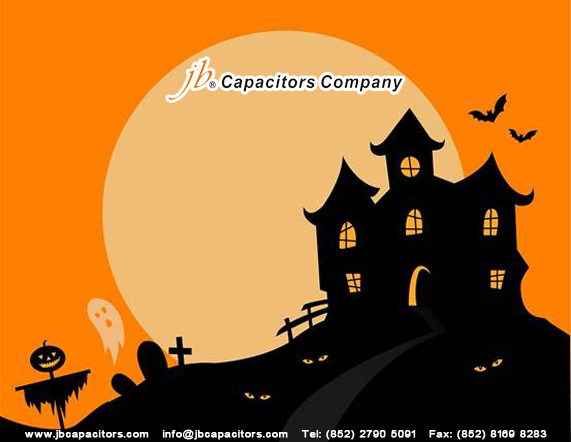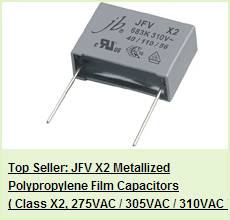2022-4-20 11:12:43
views
jb Capacitors Company is an old factory of producing various capacitors since 1980.
Are you looking for X2 MKP film capacitors recently? Our JFW series can meet your needs, and help you cost down!
JFW--X2 Metallized Polypropylene Film capacitor
Our JFW series is good alternatives for Epcos B32921~B32924, Vishay MKP3362, 3382, 3392, Panasonic ECQU, MKPX2 Wima MP3 X2 etc...
Our JFW series focus on 310VAC, with ENEC, VDE, UL certifications, unbeatable price, even better than other brand 275VAC prices.
We offer very competitive price, very short delivery time and reliable, high quality and good customer service.
Do you have any request? Please send your RFQs for a quote.

2017-10-25 19:8:44
views
November is coming means winter is also coming. Halloween is not far, do you have any plan to scare the children who will come to Trick-or-treat?
In Asia, not every kid plays trick-or-treat. But they can enjoy the decoration in school. Filled with pumpkin and evil witches, looks really creepy.
Have fun and hope you will have an impressive Halloween.

Btw, do not forget to send us the inquiry.
We have special sales for many items. Just feel free to get the most favorable price!
From jb Capacitors Company

2017-7-26 21:15:58
views
Recently, the weather is extremely hot, the Observatory of China has been repeatedly announced the hot occurrence of the Red and Orange. In order to take good care of our employees, jb. Our production line workers will enjoy one week holiday, while our sales office will still open from Monday to Friday to serve our customers. If you want to place an order, please contact with us as soon as possible to speed up the production time!
In addition, jb Capacitors warmly remind you to drink more water and not to be under the blazing sun for a long time, it is liable to get sunstroke in the hot temperature. More information please visit jb Capacitors official website: http://www.jbcapacitors.com/

2010-7-9 20:8:42
views
Aluminum electrolytic capacitors may cause an explosion, fire, or other serious trouble if not used under specified operating conditions. Please familiarize yourself with the instructions given below before using these capacitors Operating temperature and ripple current.
- 1. Keep the operating temperature and ripple current in specified ranges. Applying an excessive current to a capacitor will overheat it, resulting perhaps in short-circuit, ignition, or other fatal fault.
- 2. A capacitor is also a heating component itself. Please be on guard, remembering that it heats up the inside of the equipment. Run the unit under normal conditions and check the temperature of the surroundings of the capacitor.
- 3. The permissible ripple current tends to decline with a rise in the atmosphere temperature (the temperature of the surroundings of the capacitor). Consider a permissible ripple current at the maximum predictable atmospheric temperature. Allow also for the changes in frequency.
Applied voltage and connections
- 1. Capacitors have polarity. Applying a reverse voltage or AC voltage to a capacitor may cause a fire or other fatal fault.
- 2. Use a bipolar capacitor for circuits whose polarity reverses. However, in this case, like any other case,refrain from using such a capacitor in AC circuit.
- 3. When an AC component is superimposed on a DC voltage, prevent the peak value from exceeding the rated voltage. An excessive voltage may cause a short-circuit, fire, or other fatal fault.
- 4. When connecting more than one capacitor in parallel, consider the resistance of the wiring. Establish the connections so that the wiring resistance will be equal at every capacitor.
- 5. When more than one capacitor is connected in series, all capacitors must be of identical ratings. Then connect the balancing resistors in parallel. At that time, design the circuit so that the voltage levels applied to all capacitors become equal.Check that the voltages applied to capacitors do not exceed a rated voltage.
- 6. Do not use such a capacitor for a circuit that is repeatedly charged and discharged quickly. If you are to use such a capacitor for a welding unit or for other charging and discharging purposes, use a capacitor designed on a separate basis.
- 7. Even slow recharging may shorten the service life of a capacitor if its voltage changes greatly. Check it sufficiently as installed on a larger machine or consult Capsun.
Capacitor insulation
- 1. Do not connect the blank terminal (reinforcing terminal) of a multi-terminal (three- or four-terminal) product of the snap-in type to another circuit. It may cause a short circuit.
- 2. The external sleeve of the snap-in type has no insulator. If you need a sleeve with an insulator, consult Capsun.
- 3. Ensure a completely open circuit between the case and the cathode terminal, and between the anode terminal and circuit pattern
Operating conditions
- 1. A splash of water, salty water, oil or other electrically conductive liquid on a capacitor or using a capacitor when it has dew on it may cause a breakdown. Oil on the rubber sealing or safety vent may cause a decline in airtightness. Do not use a capacitor with liquid on it.
- 2. Do not use or leave a capacitor in a place where there is a hydrogen sulfide, nitrous acid, sulfurous acid, chlorine, bromine, or other halide compound gas, ammonia, or other hazardous gas. The ingress of any of the aforementioned gases into a capacitor may corrode it. Avoid fumigating and spraying an insecticide as well.
- 3. Do not use or leave a capacitor in a place exposed to ozone, ultraviolet ray, or radiation.
- 4. Do not use a capacitor in a place where vibration or impact is excessive.
Installa tion Before installaton
- 1. Do not reverse the polarity. Do not use a capacitor to which a reverse voltage is applied, even if it looks problem-free. It must be greatly damaged.
- 2. Do not tighten the curled part (case sealed part) with a mounting fitting or otherwise stress it. Any such practice may cause a liquid leak or sleeve breakage.
- 3. Dropping or otherwise impacting a capacitor may result in a decline in its electric performance,causing a breakdown. Therefore do not cause an impact on it.
- 4. Do not reuse a capacitor which has been installed on a machine and energized. No capacitor can be reused except for those removed to measure their electric performance for a periodic checkup.
Method of installation
- 1. Do not make the safety vent (cap side) of a screw terminal type face downwards. The safety vent may let the electrolyte or compound leak.
- 2. Do not install a wiring or circuit pattern near the safety vent. When the safety vent is activated, the electrolyte may jet out, resulting in a fire or other secondary accident.
- 3. Avoid installing a heating part around a capacitor or in back of a printed wiring board (beneath the capacitor).
- 4. Do not hamper the activation of the safety vent. Above the safety vent (where a screw terminal type is installed on the terminal side, or snap-in type on the case bottom), allow for the following clearances.






